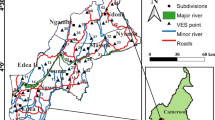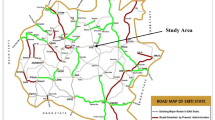Abstract
The Slingram electromagnetic (EM) survey using a coil separation of 60 and 100 m was carried out in ten villages in the Akinyele area of Ibadan, southwestern Nigeria to aid in the development of groundwater. Five main rock types including an undifferentiated gneiss complex (Su), biotite-garnet schist/gneiss (Bs), quartzite and quartz schist (Q), migmatized undifferentiated biotite/hornblende gneiss (M) and pegmatite/quartz vein (P) underlie the study area. A total of 31 EM profiles was made to accurately locate prospective borehole sites in the field.
Four main groups with different behavioural patterns were categorized from the EM profiles. Group 1 is characterized by a high density of positive (HDP) or a high density of negative (HDN) real and imaginary curves, Group 2 by parallel real and imaginary curves intersecting with negligible amplitude (PNA), Group 3 by frequent intersection of a high density of negative minima (FHN) real and imaginary curves, and Group 4 by separate and approximately parallel (SAP) real and imaginary curves. Qualitative pictures of the overburden thickness and the extent of fracturing have been proposed from these behavioural patterns.
A comparison of the borehole yield with the overburden thickness and the level of fracturing shows that the borehole yield depends more on the fracture density than on the overburden thickness. The asymmetry of the anomaly was also found to be useful in the determination of the inclination of the conductor/fracture.
Résumé
Une prospection électromagnétique Silgram (EM) utilisant une séparation de 60 et 100 m, a été réalisée sur 10 sites villageois dans la zone d’Akinyele, Ibadan, au Sud-Ouest du Nigeria, pour le développement de l’exploitation des eaux souterraines. De cette manière il a été possible de définir cinq principaux types de roches comprenant un complexe gneissique indifférencié (Su), un schiste gneissique à biotite et garnet (Bs), une quartzite et un schiste quartzitique (Q), un gneiss migmatisé à hornblende et biotite indifférenciées (M) et une veine de pegmatite et quartz recouvrant la zone d’étude. Un total de 31 profils EM a été réalisé de manière à améliorer sérieusement la localisation des forages de reconnaissance.
Quatre groupes principaux ont été définis sur base de leur comportement dans les profils EM. Le Groupe 1 est caractérisé par une forte densité de courbes réelles et imaginaires, positives ou négatives (HDP ou HDN). Le Groupe 2 est caractérisé par des courbes parallèles, réelles et imaginaires, superposées à une amplitude négligeable (PNA). Le Groupe 3 rassemble les densités importantes de courbes réelles et imaginaires, d’amplitude négative minimum, fréquemment intersectées. Le Groupe 4 rassemble les courbes réelles et imaginaires, distinctes et sensiblement parallèles (SAP). Les images qualitatives de l’épaisseur de la couverture et la largeur des fractures ont pu être déterminées sur base du comportement des éléments précédemment cités.
La comparaison des débits de forage, de l’épaisseur de la couche supérieure, et du degré de fracturation, montre que le débit du forage dépend plus de la densité de forage que de l’épaisseur de la couverture. L’asymétrie des anomalies a par ailleurs été très utile pour déterminer l’inclinaison des fractures conductrices.
Resumen
Se llevó a cabo un levantamiento electromagnético (EM) Slingram utilizando una separación de bobinas de 60 y 100 metros en 10 comunidades en el área Akinyele de Ibadan, suroeste de Nigeria para ayudar en el desarrollo de agua subterránea. Cinco tipos de rocas principales incluyendo un complejo de gneiss no diferenciado (Su), gneiss/esquisto de granate-biotita (Bs), cuarzita y esquisto de cuarzo (Q), gneiss de hornblenda/biotita migmatizado no diferenciado (M) y vetas de cuarzo/pegmatita (P) se encuentran en el área de estudio. Se levantaron un total de 31 perfiles EM para localizar con precisión sitios prospectivos para pozos en el campo. Se distinguieron cuatro grupos principales con diferente patrón de comportamiento a partir de los perfiles EM. El Grupo 1 se caracteriza por una alta densidad de curvas reales e imaginarias positivas (HDP) o negativas (HDN); el Grupo 2 por curvas paralelas reales e imaginarias que se interceptan con amplitud despreciable (PNA); el Grupo 3 por intersección frecuente de curvas reales e imaginarias con mínimos negativos de alta densidad (FHN); y el Grupo 4 por curvas imaginarias y reales separadas y aproximadamente paralelas (SAP). A partir de estos patrones de comportamiento se han propuesto cuadros cualitativos del espesor del material superficial y la extensión de fracturamiento. Una comparación de la productividad del pozo en relación al espesor del material superficial y el nivel de fracturamiento muestra que la productividad del pozo depende más de la densidad de fracturamiento que del espesor del material superficial. También se encontró que la asimetría de la anomalía era útil en la determinación de la inclinación de la fractura/conductor.








Similar content being viewed by others
References
Acworth RS (1987) The development of crystalline Basement aquifer in a tropical environment. Engng Geol 20:265–272
Amadi UMP, Teme SC (1989) The alteration scheme of some 2:1 layer clays from Basement Complex. J Min Geol 25(1/2): 33–41
Beeson S, Jones CRC (1988) The combined EMT/VES geophysical method for siting boreholes. Groundwater 26(1):54–63
de Rooy C (1986) Use of the electromagnetic method for groundwater prospecting in Nigeria. Proceedings of the first Annual Symposium, Nigeria Water and Sanitation association, Lagos pp 45–67
Edet AE (1990) Application of photogeologic and electromagnetic techniques to groundwater exploration in northwestern Nigeria. J Afr Earth Sci 11(3/4):321E–328E
Ehinola OA (2002) Hydrochemical characteristics of groundwater in parts of the Basement Complex of southwestern, Nigeria. J Min Geol 38(2):125–133
Ehinola OA, Opoola AO, Ganiyu OA (2001) Determination of Geoelectrical characteristics and implications for Borehole siting in Akinyele Area of Ibadan, southwestern Nigeria. In: Ibitoye OA (ed) Rural Environment and Sustainable Development, Dept. of Geography and planning, University of Ado-Ekiti, Nigeria, Conference Proceedings, p 18
Elueze AA (1980) Geochemical study of Proterozoic amphibolite and ultramafites in relation to Precambrian crustal evolution. Unpublished PhD Thesis Univerity of Ibadan, 141 p
Grant NK (1971) A computation of radiometric ages from Nigeria. J Min Geol 6:37–54
Greenbaum D (1985) Review of remote sensing applications to groundwater exploration in Basement and regolith. Brit Geolog Sur, Nottingham, UK 36 p
Jones HA, Hockey RD (1964) The geology of parts of southwestern Nigeria. Geolog Sur Nig Bull 20:92
Lachassagne P, Wyns R, Berard P, Bruel T, Cheryl L, Coutand T, Desprats JF, Strat PL (2001) Exploitation of high yields in hard-rock aquifers: downscaling methodology combining GIS and Multicriterial analysis to delineate field prospecting zones. Groundwater 39(4):568–581
McNeill JD (1980) Electromagnetic terrain conductivity measurement at low induction numbers. Technical Note TN-6 Geonics Ltd., Mississisaga, Canada, 15 p
Nurudeen SI, Amadi UMP (1990) EM survey and the search for groundwater in the crystalline Basement Complex of Nigeria. J Min Geol 26:45–55
Olayinka AI (1990) Electromagnetic profiling for groundwater in Precambrian Basement Complex areas of Nigeria. Nordic Hydrol 21:205–216
Olayinka AI (1992) Geophysical siting of boreholes in crystalline basement areas of Africa. J Afr Earth Sci 14(2):197–207
Olayinka AI, Weller A (1997) The inversion of geoelectrical data for hydrogeological application in crystalline Basement areas of Nigeria. Appl Geophys 37:103–115
Oyawoye MO (1970) The Basement complex of Nigeria. In: Dessauvagie TFJ, Whiteman AJ (eds) African Geology. University of Ibadan Press, Ibadan pp 67–99
Palacky GJ, Ritsema IL, De Jong SJ (1981) Electromagnetic prospecting for groundwater in Precambrian terrains in the Republic of upper Volta. Geophys Prospect 29:932–955
Rahaman MA, Malomo S (1983) Sedimentary and crystalline rocks of Nigeria. In: Ola SA, Balke MA (eds) Tropical soils of Nigeria in Engineering Practice. Netherlands, pp 17–37
Taylor R, Howard K (2000) A tectono-geomorphic model of the hydrogeology of deeply weathered crystalline rock: evidence from Uganda. Hydrogeol J 8(3):279–294
Acknowledgement
We are grateful to the entire staff of the UNICEF Assisted Water and Sanitation Project (WATSAN), Oyo State, Nigeria for making the field operations, equipment and logistics possible. We are greatly indebted to P. Lachassagne and other reviewers for their helpful comments and Professors A.I. Olayinka and T.A Badejoko for their encouragement.
Author information
Authors and Affiliations
Corresponding author
Rights and permissions
About this article
Cite this article
Ehinola, O.A., Opoola, A.O. & Adesokan, H.A. Empirical analysis of electromagnetic profiles for groundwater prospecting in rural areas of Ibadan, southwestern Nigeria. Hydrogeol J 14, 613–624 (2006). https://doi.org/10.1007/s10040-005-0468-z
Received:
Accepted:
Published:
Issue Date:
DOI: https://doi.org/10.1007/s10040-005-0468-z




